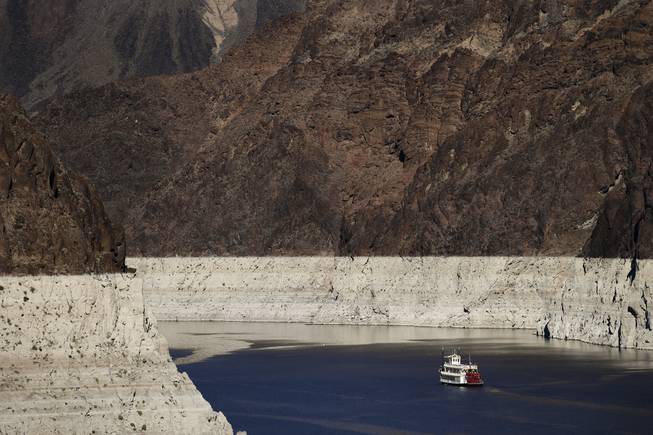
Jae C. Hong / AP
In this Oct. 14, 2015, file photo, a riverboat glides through Lake Mead on the Colorado River at Hoover Dam near Boulder City.
Saturday, March 10, 2018 | 2 a.m.
Southern Nevada’s population could grow to about 3.6 million in 50 years, sparking talks of the possibility of a water desalination plant on the shores of the Pacific Ocean, said John Entsminger, general manager of the Southern Nevada Water Authority.
The region now has an estimated population of about 2.1 million, according to the UNLV Center for Business and Economic Research. A population jump to 3.6 million people would be big but not unprecedented, Entsminger said recently on Nevada Newsmakers.
“Our valley saw about a 100 percent increase from 1985 to 2000, so historically speaking, 50 percent in 50 years is a lot less than 15 years at 100 percent,” he said.
“The numbers take in all of Southern Nevada, all of Clark County, but obviously the vast majority would be in the Las Vegas Valley,” he said.
The projections have SNWA seriously thinking about a desalination plant to turn ocean water into drinking water for Southern Nevada, he said.
“If I got my crystal ball out, I believe that in 30, 40 years from now, Southern Nevada probably will have an equity interest in a desalination facility either on the coast of California or on the Pacific coast of Mexico,” Entsminger said. “We’ve put in place a lot of legal agreements between the United States and Mexico to meet those types of exchanges possible.”
Yet any serious desalination-plant talks remain in the future.
“We just simply don’t need the water bad enough right now to move forward with that kind of hundreds of millions of dollars — or even billions of dollars — in capital investments for additional water supplies,” Entsminger said.
“We are only using about two-thirds of our legal entitlement of the (Colorado) River,” he said. “We have bank supplies equal to eight years of our current demand.”
Southern Nevada residents have also grown wiser about their water use, he said.
“Certainly, the drought along the Colorado River has been ongoing since 2002 — the worse drought in the recorded history of the river,” Entsminger said. “But in the face of that, our community has responded by driving down their usage. We use 28 percent less water from the Colorado River today than we did in 2002. So under any scenario, our community has demonstrated that they are up to the challenge.”
